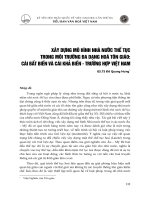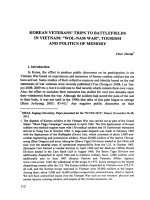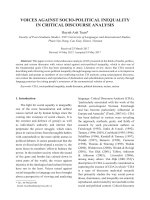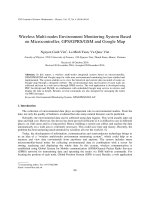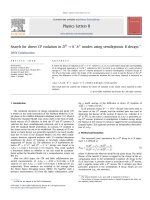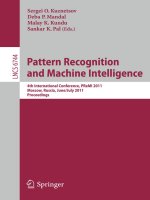DSpace at VNU: Conflict between cultural world outlooks in the era of globalization: some reasons and solutions in philosophical viewpoint
Bạn đang xem bản rút gọn của tài liệu. Xem và tải ngay bản đầy đủ của tài liệu tại đây (5.19 MB, 9 trang )
VNU.JOURNAL OF SCIENCE,
soc., SCI., HUMAN., Np5E, 2006
CONFLICT BETWEEN CULTURAL WORLD OUTLOOKS IN
THE ERA OF GLOBALIZATION: SOME REASONS AND
SOLUTIONS IN PHILOSOPHICAL VIEWPOINT
Nguyen Vu Hao(*}
1. C ultural non -u n d erstan d in g
Globalization is rapidly tak in g place
in our world. A lthough th e re are some
advantages, globalization also brings
about a lot of problems, especially in the
relationships betw een different cultures.
For the lim it of th e paper, I try to
present briefly some m ain reasons for
the conflict betw een cu ltu ral world
outlooks in the E ra of Globalization
through
the
philosophical
and
intercultural viewpoints. I will reflect on
some works by W ittgenstein and offer
some solutions based on W ittgenstein’s
insights.
I.
Discussions or violent criticism of
different cultural world-views against
each other may stem from cultural non
understanding or lack of information of
other cultures. Why is it so difficult to
understand people of other cultures? The
common and traditional conceptions
tend to believe th a t the other’s interior
thinking is completely secret, for it is
hidden in the mind and publicly
inaccessible.(2) The late W ittgenstein
criticizes sharply this point of view,
especially the thesis of C artesian on the
so-called complete secrecy of the inner
sphere. C artesian thesis is based on an
acceptance of the private language. In
W ittgenstein’s opinion, people can
perceive, to some extent, feelings (for
example feeling of pain) and thoughts of
other people through his
public
(linguistic
and
non-linguistic)
manifestation. One can not understand
actions and thoughts of people of other
cultures not because their inner thinking
is completely secret and inaccessible for
him (3), but there is another subtle reason
Why are c u ltu r a l w orld
outlook s in c o n flict w ith one
an other?
From an in tercu ltu ral point of view,
there are two m ain reasons which m ight
lead to cu ltu ral conflict: 1) conflict
between cu ltu ral forms of life; 2) conflict
between
cultural
world
outlooks.
Prim ary reasons refer to indispensable
principles of some certain form s of life.
Secondary reasons are very much
concerned
w ith
cu ltu ral
non
understanding
or
cultural
m isu n d erstan d in g /1*
Philosophy. The Anthropological Foundations for
Education and Intercultural Understanding, Hamburg:
Kovaỗ 2002, p 240-251.
(2)
See:
Wittgenstein,
Ludwig:
Philosophical
Investigations (PI) in: Wittgenstein, Ludwig. Schritten 1,
Frankfurt am Main, 1969, part II, XI, p 534-536.
(3) See in detail: "The game of thinking guess" (das
"Spiel des Gedankenerraten") in intercultural context:
n Dr., Departments of Philosophy, College of Social
Sciences and Humanities, VNU
(1) In detail see: concepts "cultural non-understanding”
and "cultural misunderstanding” in: Nguyen, Vu Hao:
The Concept o f Man in W ittgenstein’s Language
40
Conflict between cultural world outlooks in..
behind it. In fact, he is not able to
u nderstand people’s form of life, even if
their inner thinking is totally accessible
for him . The barriers of language
(foreign languages) may be the difficulty
for understanding, but it is not the
fundam ental reason for cultural nonunderstanding.(4)
The
fundam ental
reason for non-understanding is related
to “cultural blindness” i.e. not knowing
or not practicing the cultural forms of
life, language games, and the traditions
such as habits and customs of other
cultures. According to W ittgenstein, in
this view, we could not understand a lion
either, even if th a t anim al could speak(5),
for its “form of life” is completely alien.
“C ultural blindness” or cultural non
understanding can be one of (secondary)
reasons for conflicts between cultural
forms of life.
2. C u ltu ral m isu n d ersta n d in g
C u ltural blindness of a certain
culture
alone
can
not lead
to
m isunderstanding. The m ain reason for
cultural m isunderstanding consists in
PI, part II, XI, p. 536; Lutterfelds, Wilhelm:
Interkulturelles Verstehen in Wittgensteins Konzept von
Sprachspiel, Weltbild und Lebensform, in: Latterfelds,
w ., Roser, A., Raatzsch, R. (Hrsg.): Wittgenstein Jahrbuch
2000,
Frankfurt
am
Main/Ber1in/Bern/Bruxelles/NewYork/Oxford/Wien,2001,
p. 6-19.
(4) See: PI, part II, X, p. 536: "Wir sagen auch von einem
Menschen, er sei uns durchsichtig. Aber es ist fur diese
Betrachtung wichtig, dass ein Mensch far einen andem
ein Vổlliges Rătsel sein kann. Das erfahrt man, wenn
man in ein fremdes Land mit ganzlich fremden
Traditionen kommt; und zwar auch dann, wenn man die
Sprache des Landes beherrscht. Man versteht die
Menschen nicht. (und nicht darum, weil man nicht
weiss, was sie zu sich selber sprechen.) Wir kốnnen uns
nicht in sie finden."
(5) See: PI, part II, X, s. 536: "Wenn ein Lõwe sprechen
kồnnte, wir kổnnten ihn nicht verstehen."
VNU, Journal o f Science, Soc., Sci., Human., NaSE, 2006
41
subjective ways of thinking, particularly
w hen one tries to identify and perceive
people of other cultures based on his
cu ltu ral perspectives, or views them
from form of life an d world outlook of his
cu ltu ral com m unity through it’s filter of
cu ltu ral values. In other words, cultural
m isunderstanding begins w hen one tries
to see other people only in his own view
based only on th e criteria of his culture.
This way of th in k in g often gives him not
only an incom plete or one-sided picture,
b u t it also gives him a wrong picture of
other cultures.
Such
a
way of
u n d erstan d in g of other people(6) belongs
to a type of eg o cen trism or so-called
“cu ltu ral solipsism ”. As a result, the
representatives of each culture tend to
universalize th e ir own forms of life, their
own world outlook, th eir own cultural
values, and th eir own language games of
th eir culture; and th en they generalize
its criteria for distinguishing between
"correctness"
or
"incorrectness",
"rightness" or "wrongness", "goodness" or
"badness", "beauty” or "ugliness" etc..
In reality, we need to acknowledge
th a t th is ego-centric way is common and
inevitable for m ost people in all cultures.
The origin of th is asym m etric, ego
centric p a tte rn of an intercultu ral
u n d erstan d in g is, on the one hand, the
n a tu ra l inclination of h u m an beings to
generalize th e ir own culture and then
try to u n d e rsta n d other people from
th e ir subjective perspectives; because
only in th e language game of one’s own
(6) -yy|r kỡnnen uns nicht in sie finden" See: in PI, part II,
X, S. 536.
42
culture, can one com pare th e different
forms of life and verify th e ir sim ilarities
and differences. On th e o th er hand, the
ego-centric p a tte rn of u n d erstan d in g is
practicable,
w hen
one
level
of
in tercu ltu ral u n d erstan d in g is still
lim ited to a tta in an ideal p a tte rn of
understanding: the sym m etric, objective
and universal p a tte rn of understanding.
This requires a dialogue am ong different
cultures in the world to reach a common
ground and have a globally cultural
world outlook.(7)
In sum, cultural m isunderstanding is
m ainly th e resu lt of th e subjective
deduction, especially th e ego-centric way
of thinking about people of different
cultures. As a result, one m ay not even
w ant to have a sufficient knowledge of
the form of life or the world outlook of
other cultures. A lthough lack of cultural
knowledge and language or wrong
inform ation can lead to a cultural
m isunderstanding, th is factor is only a
trivial reason for the explanation.
Therefore, th e ego-centric way of
thinking about people of different
cultures is th e m ain reason for crosscultural m isunderstanding. Definitely,
cultural non - u n d erstan d in g and
m isunderstanding can create a lot of
conflicts betw een different cultural
forms of life, betw een different cultural
world outlooks, and betw een different
{7) See: Latterfelds, Wilhelm: Interkulturelles Verstehen
in Wittgensteins Konzept von Sprachspiel, Weltbild und
Lebensform, in: Liitterfelds, w., Roser, A., Raatzsch, R.
(Hrsg.): Wittgenstein - Jahrbuch 2000, Frankfurt am
Main/Berlin/Bern/Bnjxe!les/NewYork/Oxford/Wien ,2001
p. 21-22.
Nguyen Vu Hao
language games. In my opinion, th is is
the main point which the late
W ittgenstein w ants to present w ith a
hope th a t cross-cultural problems might
be resolved. Unfortunately, num erous
problems regarding the relationships
among ethnic groups, between religious
communities, and between secular
versus religious communities are still
constantly taking place in m any Asian
countries
in
this
very
era
of
globalization. And this problem is also
taking place in many countries in the
world nowadays. The roots of these
problems are the lack of a sufficient and
deep knowledge of other cultural
communities, especially the lack of
cultural tolerance and understanding
among those who represent (stand for)
th eir cultures.
Anyway, cultural non-understanding
and cultural m isunderstanding are not
main reasons for conflicts between
different world outlooks. They are only
secondary reasons. The prim ary reasons,
th e main reasons for these conflicts are
related to the fundam ental difference of
cultural world outlooks.
3. The fundam ental d ifferen ce o f
cu ltu ral w orld outlooks
Cross-cultural problems not only
stem from the lack of information and
knowledge of other cultural forms of life
or stem from wrong understanding, but
more complex issues are hidden behind.
We know th a t these intercultural
problems
would
not
be
solved
fundam entally, even if cultural non
VNU, Journal of Science, Soc., Sci„ Human., NJE, 2006
Conflict between cultural world outlooks in.
understanding and m isunderstanding
were removed successfully and entirely.
The key problem of intercultural
m isunderstanding is, first of all, related
closely to the fundam ental difference of
cultural world outlooks. These world
outlooks are based on different and
essentially incom m ensurable principles.
T hat difference can be considered as the
real and prim ary factor for possible and
potential conflicts between cultural
forms of life. Essentially, these are
conflicts
between
quite
different
principles.
The
later W ittgenstein
analyzed this problem in his work "On
certain ty ” (ũber Gewipheit). Through
num erous examples and rem arks, he
shows th a t the representatives of each
culture are not able to reach a general
agreem ent on judgm ent and language
practice, i.e., a super cultural and global
view of world.(8)
According to W ittgenstein's analysis,
it is impossible to tell w hether a culture,
a world outlook, or a form of life is
correct or not, scientific or non-scientific,
reasonable or non-reasonable, high or
low. The world outlook and the form of
life of a certain cultural comm unity give
criteria for distinguishing between
correctness or incorrectness applied only
in this comm unity. In fact, a cultural
world outlook is neither good nor bad,
neither rig h t nor wrong. It is merely the
result of a cultural heritage passed on by
(8) See: Wittgenstein, Ludwig: On Certainty (ĩber
Gewiflheit) in: Werkausgabe, Bd. 8, Frankfurt a. M.,
1989, 108, 118, 132, 153, 157, 167, 203, 231, 239, 240,
255, 262, 264, 321, 332, 333, 609 etc..
VNU, Journal o f Science, Soc., Sci., Human., NJE, 2006
43
previous generations; it is also the result
of th e whole education in each cultural
com m unity/9* It is the fundam ental
foundation of th in k in g and acting of each
m em ber in th e com m unity. In this view,
it is a m istake to judge or criticize a
certain form of life, language games, or a
cu ltu ral world outlook by an outsider.
Therefore, it is irratio n al to m easure
religious or m ythical statem en ts based
on
scientific experim ents.(10) For
example, it is nonsense to use scientific
m ethods, e.g. an analysis of chemical
composition, to reject th e Catholic beliefs
in the E ucharist: w a te r becomes blood of
C hrist’s or bread becomes the body of
C hrist.
(9) In On Certainty 94, Wittgenstein writes: "Aber mein
Weltbild habe ich nicht, weil ich mich von seiner
Richtigkeit Qberzeugt habe; auch nicht, weil ich von
seiner Richtigkeit ilberzeugt bin. Sondern es ist der
uberkommene Hintergrund, auf welchem ich zwischen
wahr und falsch unterscheide."
(10) More detailed see: Nguyen, Vu Hao, The Concept o f
Man in W ittgenstein’s Language Philosophy. The
Anthropological Foundations
for Education and
Intercultural Understanding, Hamburg: Kovaõ 2002, p.
254-259; List, E.: Zum Problem des Verstehens fremder
Kulturen: Wittgensteins Bemerkungen zu J.G. Frazers'
Golden Bough, In: List, E. u.a. (Hrsg.): W ittgenstein und
sein Einfiufi a u f die gegenwdriige Philosophie, Akten
des zweiten intemationalen Wittgenstein-Symposiums
1977, Wien, 1980, s. 471-474; Fretlổh-Thomas, Sigrid:
Interkulturelles Verstehen Oder kulturbedingtes Erklăren:
Wittgensteins Kritik an Frazer, in: Latterfelds, w . und
Salehi, Djavid (Hrsg.): " W ir kõnnen uns nicht in sie
finden. Problem s interkultureller Verstăndigung und
Koope ration” - W ittgenstein-Studien 3 (2001) Frankfurt am Main u.a.: Lang, 2001, p. 36-44; Davies, P:
"Remarks on Wittgenstein’s Remark on Frazer’s T h e
Golden Bough", in K ing’s Theological Review 6 (1983),
p. 10-14; Henderson, D.: Wittgenstein’s Descriptivist
Aproach to Understanding: Is There a Place for
Explanation in Interpretive Accounts?, in: Dialectics 42
(1988), p. 105-115; Kippenberg, H.G. und Luchesi, B.
(Hrsg.): Magie: Die sozialwissenschaftliche Kontroverse
uber das Verstehen frem den Denkens, Frankfurt am
Main, 1978.
44
Ngiyen Vu Hao
According to W ittgenstein, there is a
diversity of principled different forms of
life and a diversity of principled different
of world outlooks. Claiming th a t there is
only one tru th in some determined
cultural
world
outlooks
is
unacceptable.(11) In my opinion, the late
W ittgenstein’s position seems to support
a diversity of different cultures, a
diversity of world outlooks. In this way,
he seems to protests against the Eurocentrism
and
against
some
contemporary conceptions which attem pt
to identify the globalization with
W esternization or Americanization.
understanding model of egocentrism,
plus
subjective
standards of
a
community is used to judge a* criticize
the representatives of othei cultural
communities as well as th e ir )rinciples.
In those cases, one forgets tia t these
criteria and standards of t strange
culture is quite different from lis or her
cultural community.
For example,
Muslims are forbidden to e a t )0rk. This
does not m ean th a t all Chriitians are
forbidden to do the same, (riven the
different teachings of the two religions,
it is unacceptable for an Nuslim to
criticize a C hristian who eats p rk .
He seems to accept the fact th a t in
spite of certain sim ilarities, it is difficult
and even, in some certain contexts,
impossible to have a common principle
for different forms of life. No common
measure can be applied to compare
between different forms of life, or
between
different
cultural
world
outlooks. They belong to different
incommensurable principles. This leads
to the fundam ental barriers
for
understanding of a strange culture or a
strange cultural world outlook.
In some extreme cases, ba;ed on his
or her subjective views, one tries not
only to criticize but also to ciange the
world outlooks and forms of lie of other
cultures, i.e., to change the beliefs of
th eir representatives, and thiỉ leads to
the climax of intercultura] conflict.
Those are uncompromising struggles
between different, opposite ind even
confronted principles against eich other.
In worse cases, some represeitatives of
one group consider the repreỉentatives
of the other groups as foolish >r heretic,
for his opinion is contrary ti w hat is
generally accepted. Each of them
considers him/ herself as an orthodox
and the other as anom alous.(12)
The main reason for conflicts among
different cultures to take place is that,
especially in some cases, when the
(11) See: Latterfelds, 2001, s. 26; Mall, R. A.: Was heiBt
'aus interkultureller Sicht'?, in: Mall, R.A. und Schneider,
N. (Hrsg.): Ethik und Politik aus interkuttureller Sicht
(Studien
zur
Interkulturellen
Philosophie),
Amsterdam/Atlanta, 1996, p.2ff; Arifuku, Kogaku: Das
buddhistische Natur- und Menschenbild. Das Vertiăltnis
des Menschen zur Natur im Buddhismus, in: Takeichi,
Akihiro (Hrsg.): Das Bild von Mensch und Natur im 21.
Jahrhundert. Zur neuen Philosophie der Politik,
Gesellschaft, Technologie und Natur, Kyoto, 1995, p.
91-107.
(12) In: On Certainty 611, Wittgenstein siys: "Wo sich
wirklich zwei •Prinzipien treffen, die sich nicht
miteinander aussỗhnen kỗnnen, da erklrt jeder den
Andem far einen Narren und Ketzer." In this way, the
answer to the question, if someone is ai orthodox or
heretic is only relative, depending on the iocial cultural
and historical conditions. This is the sarTB as fact that
only in his time, Galileo Galilei or Giordaio Bruno was
considered as heretic.
VNU, Journal of Science, Soc., Sci., Humai., NJE, 2006
Conflict between cultural world outlooks in.
Therefore, the
most im portant
reasons for potential conflicts are the
diversity and the difference between
principled
incom m ensurable
and
incompatible forms of life. However, the
conflict potential alone does not yet lead
to a real conflict. Incom patible principles
lead only to the real confrontation in
extrem e cases, when one party- in their
own ego-centric way of thinking - tries to
judge, criticize, or even to oppose and to
change the world outlook of the other side.
II. Som e so lu tio n s for con flicts
b etw een
cu ltu ral
world
o u tlook s
In order to avoid the possibilities of
conflict and to solve intercultural problems,
especially conflicts between cultural world
outlooks, it is necessary to elim inate
both prim ary and secondary reasons as
discussed above. In other words, it is
necessary to elim inate cultural non
understanding
and
cultural
m isunderstanding. Also it is necessary to
treat the principal difference of cultural
world outlooks in reasonable way.
1.
E lim in a tin g th e p h en om en on
"cultural blindness"
In order to avoid non-understanding,
it is very im portant to elim inate the
phenom enon ’’cultural blindness" : not
knowing or not practicing the cultural
forms of life, language games, and the
traditions such as habits and customs of
other cultures. In order to understand
people of other cultures, one has to study
fundam entally and to know not only
about th a t culture w ith its world
VNU, Journal o f Science, Soc., Sci., Human., NJE, 2006
45
outlook, its form of life, and its language,
but also, first of all, to take p art directly
in its language games and in its forms of
life with the motto "learning by doing".
This
solution
of
the
later
W ittgenstein seems to be reasonable and
possible, especially in the era of
globalization in which people of different
cultures or of different world outlooks
have a greater chance to communicate
w ith one another through internet,
travels, and other interchange programs.
By doing so, one can communicate,
participate, and experience of other
cultures. Of course, we have to
acknowledge th a t these opportunities
are not always available for every
nation, every cultural community, and
for everyone.
2.
A void in g
u n d ersta n d in g
cu ltu ra l
m is
C ultural m isunderstanding can be
avoided if only its root is removed, i.e.
only when both following conditions are
fulfilled. First, one m ust be in contact
w ith people of other cultures or of other
cultural com m unities to get acquainted
with their language, th eir world
outlooks, and th eir "game rules'*. At the
same time, one m ust study them
basically.
In other words, the first
condition is to elim inate cultural non
understanding. Second, the asymmetric,
ego-centric p a tte rn of intercultural
understanding m ust be elim inated, and
it needs to be replaced by the symmetric,
objective and universal understanding of
people of other cultures. This needs to
Nguyem Vu Hao
46
begin w ith dialogues based on equal and
m u tual u n d erstan d in g cultures.
Of course, th is is not easy, because
the egocentrism or a so-called “cultural
solipsism” is common in every cultural
community. Besides, it is necessary to
remove psychic reasons, w hich can cause
m isunderstanding of other cultures. The
solution is to have a to leran t attitu d e
and high respect tow ard other cultures.
3.
S o lu tio n s
c o n c e r n in g
th e
p rin cip a l d iffe r e n c e o f cu ltu ra l
w orld o u tlo o k s
Because th e principal difference of
cultural world outlooks is the main
reason for potential conflict between
different cultural com m unities, it is not
simple to overcome th e differences.
According to th e la te r W ittgenstein,
conflict risks betw een incom m ensurable
principles can be reduced and even
avoided, if a "peaceful coexistence”
betw een principles or betw een different
world outlooks is accepted as long as
people stop to universalize th e ir own
criteria, the stan d ard s of th e ir own
cu ltu ral com m unity and to criticize
strange cu ltu ral world outlooks. Because
in some certain contexts, it is impossible
to correct th e contrary principles in
order to reach a consensus. Thus, the
first solution for preventing conflicting
risks betw een th e contradictory world
outlooks is avoiding every dispute. This
is a n eu tral solution, and it requires a
recognition and respect for th e diversity
of different and even contrary world
outlooks.
C ultural conflict happens inevitably,
when this person considers his/her own
form of life and world outlook as the
criteria for criticizing or even refuting
other's world outlooks. The second
solution for uncompromising conflicts of
principles is persuasion.(13) This solution
does
not
depend
on
the
acknowledgement of the subjective
intention. In order to realize a fanatical
persuasion in order to spread their own
form of life, people often use rational
procedures and then try to reject the
other’s world outlooks by arguments
which support th eir own correctness of
language game and their own form of
life. Although the strategy seems
aggressive, it is still a peaceful approach.
One greater concern is that some
people m ight use persuasion through the
form of violence, in stead of peaceful one.
Violent persuasion usually goes along
w ith some extrem e strategies such as
using m ilitary force, terrorism, or wars
to oppress the other side. In these cases,
the other side would react strongly
including retaliation or revenge. As a
consequence, both sides are stuck in a
confused circle, and it finds extremely
difficult to get out of the spiral. The
situation m ight lead to hatred and
hostility tow ard each other. And it is
also a result of irreconcilable struggles
among the cultures, or "clash of
civilizations" in a world scale as Samuel
H untington
warned.
Once
the
representatives of one side - in extreme
cases - sense th a t they are driven to a
(13) On Certainty 262.
VNU, Journal of Science, Soc., Sci., Human., NJE, 2006
Conflict between cultural world outlooks in.
corner or there m ight be a th re a t for the
destruction of their own culture and
their own form of life, then they m ust
use all m eans they can afford, including
barbarous and terrorist m eans, to defend
fanatically their cultures and values.
They will act w ithout thinking of ethical
values, even sacrificing th eir own lives.
They are ready to die for the so called
“ju st w ar” in the battles of cultures. The
currently international terrorism is a
clear evidence for that.
In my opinion, the effectiveness of
this solution - the persuasion of people of
other cultures w ith violent to "civilize”
and to "assimilate" the other’s forms of
life, which is taking place in our
contem porary process of globalization needs to be questioned. This approach is
doubtful and unacceptable, for it brings
more destruction th an peace.
U nfortunately,
the
persuading
approach is still a common solution for
cultural conflict, for its m ain purpose is
to convert people of other cultures. Of
course, the m otivation behind are other
hidden factors such as economical
interests and political power. In the past
history, th is solution could bring some
certain
results.
In
this
era
of
globalization and in the era of the atomic
weapons, however, this solution is
totally unsuitable.
The th ird solution for conflicts of
world outlooks is the orientation to a
common and global cultural world
outlook. This solution is based on the
common foundation of people in all
cultures, th a t is, the sim ilarity in the
'NU, Journal of Science, Soc., Sci., Human., N^E, 2006
47
way of th in k in g an d acting of all people
as an essence of h u m an species in
general.
G radual
changes,
transform ation, an d acceptance of world
cu ltu ral outlook are necessary and
indispensable.
Given
th a t,
the
contem porary globalization should be
done w ith th is model. Globalization
should not be e ith e r W esternization or
A m ericanization. G lobalization is not
born by some culture w hich tries to force
or swallow up all other cultures.
Globalization does not accept the
arro g an t a ttitu d e s of some cultures and
underestim ation of other cultures a t the
sam e tim e. Good globalization is possible
only through dialogues betw een different
cultures in the world on th e level of
equality. T h at is th e approach of the
sym m etric, objective, an d universal
p a tte rn of thinking. In th is model, the
represen tativ es
of
each
cultural
com m unity need to be aw are of the
contrary to th e trad itio n al asym m etric,
ego-centric p a tte rn of thinking. In order
to do th a t, education for a civilized world
in which everyone is a citizen of the
world, is th e crucial condition for a great
globalization.(14)
Of course, th e common, global
cu ltu ral
world
outlook
and
the
globalization need to aim to build a
united world in a diverse world of
cultures (or in th e diversity of th e world
(14) See: Treml, Alfred K.: Die Erziehung zum
Weltbarger. Euphemismus Oder F iguration?, in: Treml,
Alfred K. (Hrsg.): N atur der M oral? Ethische Bildung im
Horizont der modemen Evolutionsforschung, Frankfurt
am Main, 1997, s. 56-63. Sistenzanthropoiogie 1.-6.
Septem ber 1986 an der U niversitat Bamberg, Frankfurt
am Main/Bem/New York/Paris, 1988, s. 171-186.
48
outlooks); it does not m ean excluding the
diversity of cultures or th e diversity of
the world outlooks a t all.
Anyway, th e form ation of the
common, global cu ltu ral world outlook as
a universal basis for in tercu ltu ral
u n derstanding is an extrem ely difficult,
complicated, and long process. I t cannot
take place autom atically, w ithout a
collaboration of th e rep resen tativ es of
different cultures. The m ore sim ilar
cultural world outlooks are, th e sm aller
cu ltu ral conflicts betw een them and the
b etter
chances
for
in tercu ltu ral
u n derstanding become. On th e contrary,
th e more different world outlooks are,
th e greater change for cu ltu ral conflicts
occur.
Therefore, learning to und erstan d
quite different, opposite cultures and
th e ir world outlooks is th e crucial thing.
It is th e reason why th e late
W ittgenstein, tries to point out some
reasons and to give some effective
Nguyen Vu Hao
adequate solutions for cultural and
intercultural conflict. This is to say that
the later W ittgenstein laid an im portant
foundation
for
the
contemporary
intercultural philosophy. In my opinion,
however, there are main lim itations in
his
conception.
First,
the
later
W ittgenstein
tends
to
analyze
intercultural conflicts only in a social,
cultural, and intercultural context. He
does not seem to pay enough attention to
other reasons such as economical
interests, political power, or territorial
requirem ents, which might be standing
behind intercultural conflicts. Second,
the later W ittgenstein is not able to
analyze in detail how to change and to
approach different forms of life and
world outlooks so th a t it can reach a
common, globally cultural world outlook.
In my opinion, overcoming those
lim itations will open new perspectives
for
intercultural
understanding,
especially in the age of globalization.
VNU, Journal o f Science, Soc., Sci., Human., N£E, 2006
